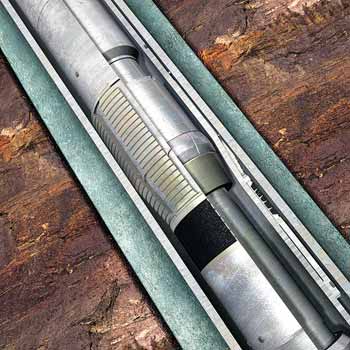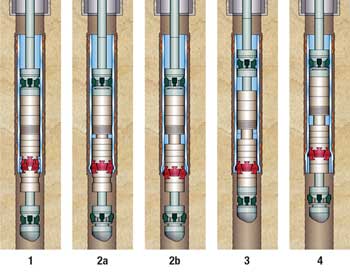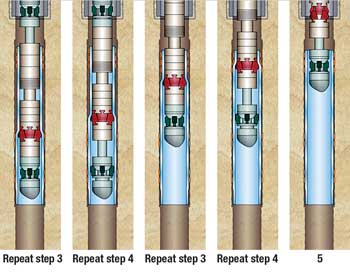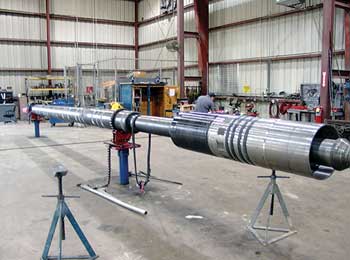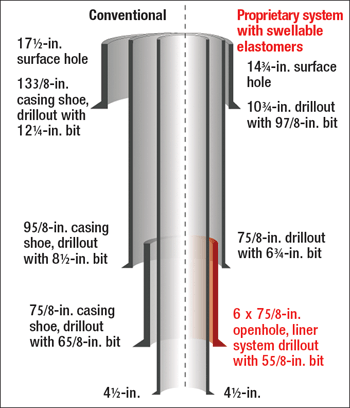New offerings fill in the gaps of expandables technology
As this technology becomes well established, step-change innovations are less common, while new applications expand to meet operators’ drilling challenges.David Michael Cohen, Managing Editor This is the seventh consecutive installation of World Oil’s annual roundup of expandable technology, and the modest number of new products coming to market indicates that this technology has come into its own as a mainstream solution for various drilling, casing and production problems. Nevertheless, operators continue to find demanding applications for established expandable technologies, spurring suppliers to fine-tune designs for these new challenges. In the current installment, we present a liner packer system from Baker Hughes that can be run and installed conventionally, now in production with a new metal-to-metal sealing element; a monobore openhole clad system from Weatherford to isolate openhole problem areas prior to drilling ahead, with a successful rig trial; new, larger-diameter versions of TIW’s expandable liner hanger systems, for deepwater and extended-reach drilling operations; and new applications of Enventure’s high-collapse-pressure solid expandables and expandables with swellable elastomers. BAKER OIL TOOLS The TORXS expandable liner hanger packer system presented in this article three years ago is now in production, with a new metal-to-metal sealing element replacing the original metal and elastomer design, Fig. 1. The tool is being successfully used primarily in Latin America, with about 35 runs to date. The one-trip, two-stage system can be run and installed conventionally, without requiring a plug bump as the primary activation method for the hanger or packer, or for release of the running tool.
All hydraulic activations occur from pressure acting on a positive seal in the running tool, eliminating the risk of poor liner-to-cement bonding that can occur when a liner is ballooned with a high-pressure plug bump. It also eliminates the need to compromise the optimum cement formulation with additional retardants or other additives that extend the cementing pump time. And, since the hanger can be set before displacing cement, there is no risk of becoming stuck in cement. The metal-to-metal sealing technology, proven in more than 20,000 liner packer installations, provides seamless one-trip, two-stage hanger and packer setting for cemented liners. The system is rig ready for a variety of operations including deviated, deep or shallow, or extended-reach wells; straight holes; frac or scab liners; liner tiebacks; and monobore completions. WEATHERFORD With funding and testing by a Norwegian operator, Weatherford has developed a new 8½-in. MetalSkin monobore openhole clad system to isolate openhole problem areas prior to drilling ahead. It provides a much faster and more cost-efficient method than pumping thicker muds and cement in an attempt to seal a formation or stabilize a sloughing formation. The solid steel barrier keeps the formation from falling in and fluid from flowing out. This low-risk system provides zero loss of hole size after installation. It will also allow a new clad to be run through an already installed clad to provide the same drift as the hole after installation. A section of pipe is run into open hole and expanded to a drift ID greater than 8½ in., without being tied back to the existing casing shoe to achieve zonal isolation. The system is ideal for treating lost-circulation zones, overpressured formations, zones with shallow flows and sloughing formations. The clad can include conventional or swellable elastomeric bands to create pipe-to- The clad has a running OD of about 8 in.; actual OD will depend on the seal element OD for potential isolation against the formation. Thus, the openhole section over the setting depth will be opened up to 9½ in. to 9⅝ in. The clad system mitigates the risks of drilling trouble zones without forcing the entire wellbore to be lined. The trouble zone is minimally under-reamed (1 in.), and the clad system is expanded into it. Operators can then resume drilling with the same size bit (because the clad allows full bore access) and complete the well as planned, without downsizing. The installation sequence is as follows (Fig. 2): 1. The expandable clad, with the expansion tool installed, is run to setting depth. 2. a) A ball is dropped to close off the work string. The initial pressure cycle will open the slips, and the cone will form inside the clad. b) When the cone has fully formed, additional pressure will shear the release ring and allow the cone to move downward and expand out of the clad. 3. The pressure is bled off; the cone remains fully formed while the upper slips disengage from the inside of the liner. The work string is pulled up 1.3 m to reset the main expansion jacks. 4. Pressure is reapplied to stroke the main jacks and begin expansion. The first upward stroke will disengage the carrying thread that held the liner while RIH. Steps 3 and 4 are repeated until the entire length of the clad is expanded. 5. When expansion is complete, the cone is collapsed with hydraulic pressure or by mechanical release. It can then be retrieved through 9⅝-in. casing.
A successful rig trial of the clad system was performed in May 2009. A wellbore consisting of 9⅝-in., 53.5-lb/ft casing and 100 m of 10¾-in. casing was used. The 10¾-in. casing simulated the 9⅝-in. under-reamed open hole. Seventy-five meters of 8-in. expandable casing was picked up and run to the chosen setting depth inside the 10¾-in. casing. The clad was successfully expanded, then the cone was hydraulically deconstructed and recovered to surface through the 9⅝-in. casing. A subsequent drift run showed that the clad had been expanded to allow a 8½-in. mill to pass. The rig trial was considered a success by both the service company engineers and the Norwegian operator’s personnel. A field trial of the system is being planned for the third quarter of 2009, with subsequent plans for a pilot test in the operator’s well by the beginning of 2010. TIW In the last year, TIW has expanded its large-OD line of XPac expandable liner hanger systems for deepwater and extended-reach drilling operations, with recent successful installations of 9⅝ x 11¾-in., 11¾ x 13⅝-in., 10¾ x 14-in. and 14 x 16-in. hanger systems. Additional testing has been completed on 16 x 20-in. and 18 x 22-in. sizes, Fig. 3.
These large-diameter Expandable Liner Hanger (ELH) systems are capable of providing hanging load capacities in excess of 1 million lb, providing burst and collapse ratings equal to those of the liner and differential ratings well above those of conventional compression-set liner packers. The challenge in large-diameter systems is providing service tools with the durability to handle the combined load of liner weight and setting forces as well as torque capability for rotation or drilling with liner. The 10¾-in. ELH setting tool has a combined load capability of 2.2 million lb, while the 14-in. ELH setting tool has a combined load capability of 3.5 million lb. Both size tools have a torque capability of 121,000 ft-lb. Design review and preliminary testing procedures are being conducted for larger systems in the 24-in. to 36-in. range. ENVENTURE The SET High-Performance system from Enventure had its first commercial application in the UK sector of the North Sea in 2007. The expandable system has thick-walled pipe and enhanced connections performance that provide a higher collapse and burst pressure rating than conventional solid expandable liners. A major international operator was planning an infill drilling and appraisal program in 302 ft of water at a depth of about 16,400 ft, to a reservoir of high-pressure (> 100 MPa) and high-temperature (> 180°C) gas condensate. Uncertainty of shale stability in the high-pressure cap rock above the reservoir meant careful progression through this section would be important to minimize the risk of stimulating movement or collapse. The operator needed a way to isolate the cap rock before entering the reservoir so that a lower mud weight could be used when drilling through the already depleted section of the reservoir. Isolating the cap rock by casing off conventionally would require telescoping the wellbore architecture to a point where valuable production rate would be lost. A 7⅝ x 9⅞-in. high-performance expandable system was installed, providing about a 60% increase in collapse pressure compared with standard SET systems. The expandable system effectively isolated the high-pressure cap rock’s unstable shale. With the high-pressure section isolated, the operator was able to reduce the mud weight and drill ahead into the depleted section of the reservoir without jeopardizing the integrity of the formation, and reach the planned TD. The increased collapse rating of the solid expandable system provided immediate isolation as well as a long-term solution that will withstand the expected increased pressure differential as the depletion continues over the 7-year projected lifecycle of the well. Based on the system’s success, Enventure is releasing a new, 11¾ x 13⅜-in. version of the high-performance expandable system for uses such as setting deeper casing points and extended-reach drilling. Other developments from the company include the advancement of SET technology with swellable elastomers to provide zonal isolation without cementing. The first key application of this technology was used to achieve a slimmer well profile without having to under-ream the hole section or cement the expandable liner. In a Central Texas application, the operator was already using SET systems in a well-slimming program that reduced upper hole sizes, thereby improving ROP and reducing overall costs. To further save time, the need for under-reaming and cementing the expandable system was eliminated by incorporating a specialized expandable joint with swellable elastomers, Fig. 4.
A 6 x 7⅝-in. solid expandable system with 5⅞-in. drillout was run below the 29.7-lb, 7⅝-in. base casing and expanded. Previously, this installation required under-reaming a 7¼-in. hole section. In this installation, a 6¾-in. section was drilled without under-reaming. An expandable joint with swellable elastomers was installed above the launcher to provide zonal isolation, thus eliminating the need for cementing. In addition to the $1 million per well of savings realized by slimming the well with the 6 x 7⅝-in. SET systems, the elimination of under-reaming saved 5 to 7 additional days of rig time (equating to an additional $300,000 in savings). Since this first application, expandable systems with swellable technology are being targeted for use offshore and have already been installed through window exits. Click here for a complete list of World Oil’s annual expandable technology reports.
|
- Coiled tubing drilling’s role in the energy transition (March 2024)
- Using data to create new completion efficiencies (February 2024)
- Digital tool kit enhances real-time decision-making to improve drilling efficiency and performance (February 2024)
- E&P outside the U.S. maintains a disciplined pace (February 2024)
- Prices and governmental policies combine to stymie Canadian upstream growth (February 2024)
- U.S. operators reduce activity as crude prices plunge (February 2024)
- Applying ultra-deep LWD resistivity technology successfully in a SAGD operation (May 2019)
- Adoption of wireless intelligent completions advances (May 2019)
- Majors double down as takeaway crunch eases (April 2019)
- What’s new in well logging and formation evaluation (April 2019)
- Qualification of a 20,000-psi subsea BOP: A collaborative approach (February 2019)
- ConocoPhillips’ Greg Leveille sees rapid trajectory of technical advancement continuing (February 2019)

